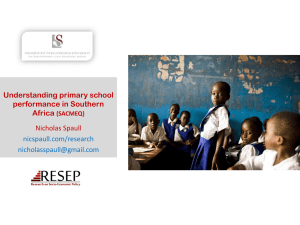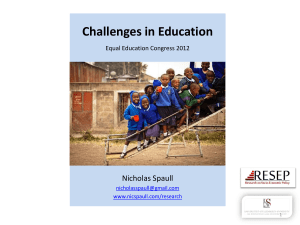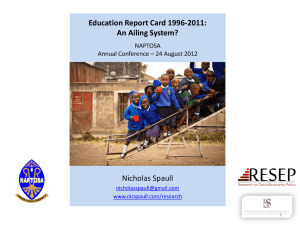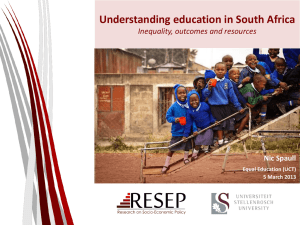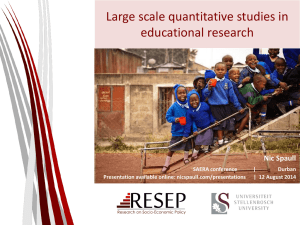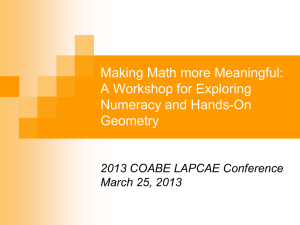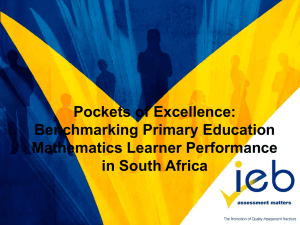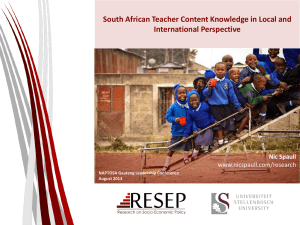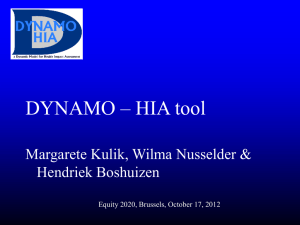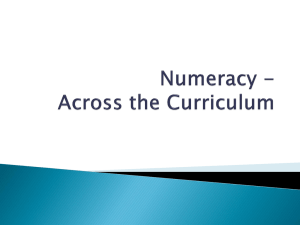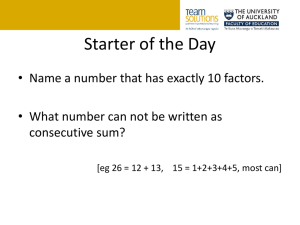Primary School Inequality in South Africa
advertisement
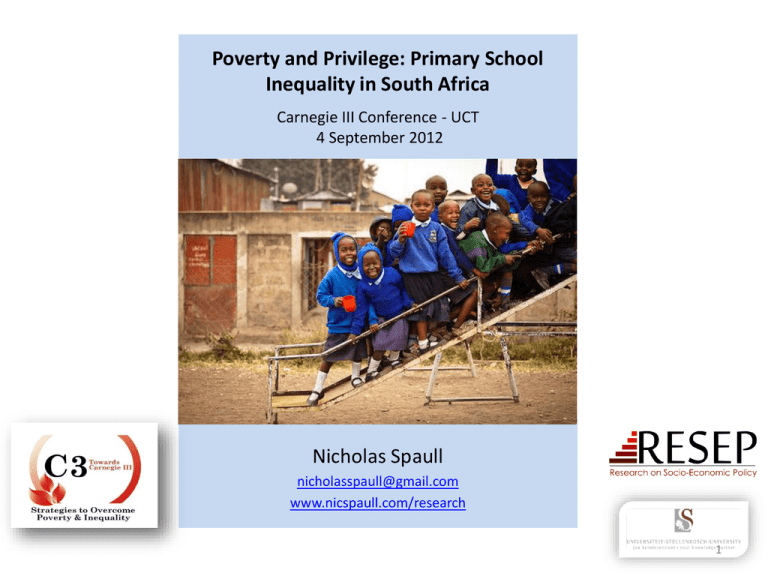
Poverty and Privilege: Primary School Inequality in South Africa Carnegie III Conference - UCT 4 September 2012 Nicholas Spaull nicholasspaull@gmail.com www.nicspaull.com/research 1 Education and inequality? Quality of education Duration of education Type of education SA is one of the top 3 most unequal countries in the world Between 78% and 85% of total inequality is explained by wage inequality Wages • IQ • Motivation • Social networks • Discrimination Outline 1. Rationale for the research 2. Extant literature on education inequality in SA – Two education systems not one 3. Theoretical framework: Schooling & Poverty 4. Modelling two data generating processes – – Deciding where to split the distribution into two? Do the same factors affect both systems? 5. Conclusions & Recommendations 3 Rationale Chapter 2 Literature Review Human capital is of economic importance Cognitive skills are a better measure of human capital than educational attainment. Cognitive skills in South Africa are remarkably low and highly unequal • • Resources Physical and human resources are highly inequitably distributed across provinces, socioeconomic quintiles, and school locations. Performance Reading and mathematics performance are highly inequitably distributed across provinces, socioeconomic quintiles and school locations. Performance Most South African schools are unable to produce learners who can satisfy the demands of curriculum. Chapter 3 Preliminary Analysis Theoretically education can play a large role in social mobility. Why has it not fulfilled this role in SA? Bimodality in student achievement data? Efficiency Dimension Resources South Africa in regional context: Other countries in Sub-Saharan Africa perform better with fewer resources. Chapter 4 Modelling Learner Performance • Not all schools are equally able to convert additional resources into educational outputs. How can one increase the cognitive skills of South African primary school children? Modelling learner performance in South Africa Conclusion 4 Chapter 5 Conclusion Equity Dimension Not all schools are born equal ? SA public schools? 5 • (Shepherd, 2011) .004 .003 0 • Grade 5 [2006] • Data: PIRLS .002 Language .001 kdensity reading test score .005 Extant literature: Two school systems not one 0 200 400 reading test score African language schools 600 800 English/Afrikaans schools 6 (Taylor, 2011) .01 0 • .005 • Grade 4 [2008] • Data: NSES Density Ex-department .015 .02 .025 Two school systems not one 0 20 40 60 Numeracy score 2008 Ex-DET/Homelands schools 80 100 Historically white schools 7 2 Systems Kernel Density of Literacy Score by Race (KZN) 0 .0 05 .0 1 D en sity .0 15 .0 2 U-ANA 2011 0 20 Race • Grade 1-6 [2011] • Data: ANA 2011 40 60 Literacy score (%) Black White Indian Asian 80 100 80 100 Kernel Density of Numeracy Score by Race (FST) 0 .0 05 .0 1 D en sity .0 15 .0 2 U-ANA 2011 0 20 40 60 Numeracy score (%) Coloured Black White 8 2 education systems Dysfunctional Schools (75% of schools) Functional Schools (25% of schools) Weak accountability Strong accountability Incompetent school management Good school management Lack of culture of learning, discipline and order Culture of learning, discipline and order Inadequate LTSM Adequate LTSM Weak teacher content knowledge Adequate teacher content knowledge High teacher absenteeism (1 month/yr) Low teacher absenteeism (2 week/yr) Slow curriculum coverage, little homework or testing Covers the curriculum, weekly homework, frequent testing High repetition & dropout (Gr10-12) Low repetition & dropout (Gr10-12) Extremely weak learning: most students fail standardised tests Adequate learner performance (primary and matric) See Hoadley (2010), Fleisch (2008), Van der Berg et al (2011), Taylor (2012) as a few of many 9 Teaching Characterised by: • • • • High productivity jobs and incomes (10%) • Type Labour Market Mainly professional, managerial & skilled jobs Requires graduates, good quality matric or good vocational skills Historically mainly white • • University/ FET • • Low productivity jobs & incomes • • Often manual or low skill jobs Limited or low quality education Minimum wage can exceed productivity - Minority (20%) Big demand for good schools despite fees Some scholarships/bursaries Unequal society Majority (80%) Low quality secondary school Low SES background Low quality primary school Attainment • High SES background High quality primary school Some motivated, lucky or talented students make the transition Vocational training Affirmative action Quality • • Strong accountability Well managed & organized Good school discipline Culture of L & T High quality secondary school Type of institution (FET or University) Quality of institution Type of qualification (diploma, degree etc.) Field of study (Engineering, Arts etc.) • • Schools Characterised by: • • • • High cognitive demand Full curriculum coverage Adequate LTSM Frequent assessment cf. Servaas van der Berg Teaching Characterised by: • • • • • Low cognitive demand Slow curriculum coverage Inadequate LTSM Weak & infrequent assessment Weak teacher content knowledge Schools Characterised by: • • • • • Little parental involvement No accountability Little discipline 10 Weak management High teacher absenteeism Teaching Characterised by: • • • • High productivity jobs and incomes (10%) • Type Labour Market Mainly professional, managerial & skilled jobs Requires graduates, good quality matric or good vocational skills Historically mainly white • • University/ FET • • Low productivity jobs & incomes • • Often manual or low skill jobs Limited or low quality education Minimum wage can exceed productivity - Minority (20%) Big demand for good schools despite fees Some scholarships/bursaries Unequal society Majority (80%) Low quality secondary school Low SES background Low quality primary school Attainment • High SES background High quality primary school Some motivated, lucky or talented students make the transition Vocational training Affirmative action Quality • • Strong accountability Well managed & organized Good school discipline Culture of L & T High quality secondary school Type of institution (FET or University) Quality of institution Type of qualification (diploma, degree etc.) Field of study (Engineering, Arts etc.) • • Schools Characterised by: • • • • High cognitive demand Full curriculum coverage Adequate LTSM Frequent assessment cf. Servaas van der Berg Teaching Characterised by: • • • • • Low cognitive demand Slow curriculum coverage Inadequate LTSM Weak & infrequent assessment Weak teacher content knowledge Schools Characterised by: • • • • • Little parental involvement No accountability Little discipline 11 Weak management High teacher absenteeism Splitting the 2 systems • If there are indeed two education systems in SA and not one, where/how do we draw the line between one and the other? 12 .0 08 SACMEQ III South Africa .0 04 0 0 .0 02 .0 02 .0 04 D en sity .0 06 .0 06 .0 08 SACMEQ III South Africa 0 0 200 400 600 Student Reading Score Poorest 50% 800 200 400 600 Student Reading Score 1000 Poorest 33% Wealthiest 50% 1000 Middle 33% Kernel Density of Student Reading Score by School SES Quintile Kernel Density of Student Reading Score by School SES Quartiles SACMEQ III South Africa SACMEQ III South Africa .0 04 .0 02 .0 04 D en sity .0 06 .0 06 .0 08 .0 08 800 Wealthiest 33% 0 0 .0 02 D en sity Kernel Density of Student Reading Score by School SES Terciles Kernel Density of Student Reading Score by School SES (half) 0 0 200 400 600 Student Reading Score 800 200 1000 400 600 Student Reading Score 800 Poorest 20% Second Poorest 20% Poorest 25% Second Poorest 25%% Middle 20% Second Wealthiest 20% Second Wealthiest 25% Wealthiest 25% Wealthiest 20% 1000 • (Spaull, 2011) .0 04 0 • Grade 6 [2007] • Data: SACMEQ .0 02 Socioeconomic Status D en sity .0 06 .0 08 Two school systems not one 0 200 400 600 Learner Reading Score 800 Poorest 25% Second poorest 25% Second wealthiest 25% Wealthiest 25% 1000 14 Comparing SA & Botswana Source: Spaull, 2011 .0 06 .0 04 0 .0 02 Teacher knowledge Teacher absenteeism Textbook access Literacy/numeracy rates Grade repetition Parental education Homework frequency D en sity • • • • • • • .0 08 Corroborating evidence? 0 200 400 600 Learner Reading Score 800 Poorest 25% Second poorest 25% Second wealthiest 25% Wealthiest 25% 1000 16 Teacher knowledge SACMEQ III (2007) 401/498 Gr6 Mathematics teachers 7 Correct answer (7km): 38% of Gr 6 Maths teachers SACMEQ Maths teacher test Q17 Correct 1 23% 2 22% Quintile 3 38% 4 40% 5 74% Avg 38% 2 education systems 17 Teacher absenteeism SACMEQ III South Africa Quintile 1 • What is the distribution of teacher absenteeism across school SES quintiles? Quintile 4 Quintile 3 Quintile 2 Quintile 5 0 10 20 30 Days absent per year 40 50 excludes outside values 18 60 40 0 • What proportion of students are reaching higher order competency levels? 20 Percent 80 100 Student competency levels 5 4 3 2 1 Quintiles of School Socio-economic Status Reading Competency Levels L1 - Pre Reading L2 - Emergent Reading L3 - Basic Reading L4 - Reading for Meaning L5 - Interpretive Reading L6 - Inferential Reading L7 - Analytical Reading L8 - Critical Reading 19 Do the ends justify the means? Drowning in 6 inches There was a nonswimmer from Berlin, Who loved statistics and gin, It’s little surprise that he reached his demise While crossing a stream of average depth six inches SACMEQ III Reading scores: Mean – Median SACMEQ Standard deviation approx 100 35 31 30 25 20 15 15 10 14 12 10 17 16 10 7 5 5 2 0 0 -5 -10 BOT KEN LES MAL MOZ NAM SOU SWA TAN UGA ZAM ZAN ZIM -6 20 21 Modelling student performance • Two data-generating processes. Little reason to believe there is the same underlying DGP • Split samples – Wealthiest 25% of schools – Poorest 75% of schools • Which coefficients are large & significant across the two regressions? 22 11/29 variables common 5/27 variables common Conclusions & Implications We have 2 education systems in South Africa 25 Conclusions & Implications We have 2 education systems in South Africa 1. Reporting education statistics in SA – Means are uniquely misleading in SA – the average child does not exist in any meaningful sense – Report educational statistics by quintile in addition to province – You can’t solve a problem that doesn’t officially exist 2. Modelling educational performance in SA – Modelling a single education system when there are two can lead to spurious results 3. Policy differentiation – – – Policies suited to one system are not necessarily suited to the other Don’t interfere with high-performing schools If it aint broke don’t (try) fix it LITNUM intervention in WC Blanket approach 26 Conclusions & Implications Low quality education Low social mobility Hereditary poverty Persistent patterns of poverty and privilege 27 3 biggest challenges - SA 1.Failure to get the basics right • • Children who cannot read, write and compute properly (Functionally illiterate/innumerate) after 6 years of formal full-time schooling Often teachers lack even the most basic knowledge 2.Equity in education • • 2 education systems – dysfunctional system operates at bottom of African countries, functional system operates at bottom of developed countries. More resources is NOT the silver bullet – we are not using existing resources 3.Lack of accountability • • • Little accountability to parents in majority of school system Little accountability between teachers and Department Teacher unions abusing power and acting unprofessionally 28 Way forward? 1. Acknowledge the extent of the problem • Low quality education is one of the three largest crises facing our country (along with HIV/AIDS and unemployment). Need the political will and public support for widespread reform. 2. Focus on the basics • • • • • Every child MUST master the basics of foundational numeracy and literacy these are the building blocks of further education – weak foundations = recipe for disaster Teachers need to be in school teaching (re-introduce inspectorate?) Every teacher needs a minimum competency (basic) in the subjects they teach Every child (teacher) needs access to adequate learning (teaching) materials Use every school day and every school period – maximise instructional time 3. Increase information, accountability & transparency • • • At ALL levels – DBE, district, school, classroom, learner Strengthen ANA Set realistic goals for improvement and hold people accountable 29 Education “Education is the great engine of personal development. It is through education that the daughter of a peasant can become a doctor, that the son of a mineworker can become the head of the mine, that a child of farmworkers can become the president” – Nelson Mandela If we looked at 200 Grade 1 children 12 years ago and then look at them again in matric, only 1 out of the 200 were eligible for a maths or science degree based on their matric marks – the correspodning figure for white children was 15 times higher. 30 References • • • • • • • • • • Fleisch, B. (2008). Primary Education in Crisis: Why South African schoolchildren underachieve in reading and mathematics. Cape Town. : Juta & Co. Hoadley, U. (2010). What doe we know about teaching and learning in primary schools in South Africa? A review of the classroombased research literature. Report for the Grade 3 Improvement project of the University of Stellenbosch. Western Cape Education Department. Hungi, N., Makuwa, D., Ross, K., Saito, M., Dolata, S., van Capelle, F., et al. (2011). SACMEQ III Project Results: Levels and Trends in School Resources among SACMEQ School Systems. Paris: Southern and Eastern Africa Consortium for Monitoring Educational Quality. Ross, K., Saito, M., Dolata, S., Ikeda, M., Zuze, L., Murimba, S., et al. (2005). The Conduct of the SACMEQ III Project. In E. Onsomu, J. Nzomo, & C. Obiero, The SACMEQ II Project in Kenya: A Study of the Conditions of Schooling and the Quality of Education. Harare: SACMEQ. Shepherd, D. (2011). Constraints to School Effectiveness: What prevents poor schools from delivering results? Stellenbosch Economic Working Papers 05/11. [PIRLS] Spaull, N. (2011a). A Preliminary Analysis of SACMEQ III South Africa.Stellenbosch Economic Working Papers. Spaull, N. (2011). Primary School Performance in Botswana, Mozambique, Namibia and South Africa. Paris: Southern and Eastern African Consortium for Monitoring Educational Quality (SACMEQ) Working Paper no.8. Spaull, N. 2012 Equity & Efficiency in South African primary schools : a preliminary analysis of SACMEQ III South Africa Masters Thesis. Economics. Stellenbosch University Taylor, S. (2011). Uncovering indicators of effective school management in South Africa using the National School Effectiveness Study.Stellenbosch Economic Working Papers 10/11, 1-51. [NSES] Van der Berg, S., Burger, C., Burger, R., de Vos, M., du Rand, G., Gustafsson, M., Shepherd, D., Spaull, N., Taylor, S., van Broekhuizen, H., and von Fintel, D. (2011). Low quality education as a poverty trap. Stellenbosch: University of Stellenbosch, Department of Economics. Research report for the PSPPD project for Presidency. 31 www.nicspaull.com/research nicholasspaull@gmail.com @NicSpaull 32 33 Description of Range on 500 levels point scale Level 1 Pre-reading < 373 Skills Level 2 Emergent reading Matches words and pictures involving prepositions and abstract concepts; uses cuing systems (by sounding out, using simple sentence structure, and familiar words) to interpret phrases by reading on. 373 414 [1] Level 3 Basic reading Level 4 Reading for meaning Level 5 Interpretive reading Level 6 Inferential reading Level 7 Analytical reading Matches words and pictures involving concrete concepts and everyday objects. Follows short simple written instructions. See Ross et al. (2005, p. 95). 414 457 Interprets meaning (by matching words and phrases, completing a sentence, or matching adjacent words) in a short and simple text by reading on or reading back. 457 509 Reads on or reads back in order to link and interpret information located in various parts of the text. 509 563 Reads on and reads back in order to combine and interpret information from various parts of the text in association with external information (based on recalled factual knowledge) that “completes” and contextualizes meaning. 563 618 Reads on and reads back through longer texts (narrative, document or expository) in order to combine information from various parts of the text so as to infer the writer’s purpose. 618 703 Locates information in longer texts (narrative, document or expository) by reading on and reading back in order to combine information from various parts of the text so as to infer the writer’s personal beliefs (value systems, prejudices, and/or biases). Level 8 Critical reading 703+ Locates information in a longer texts (narrative, document or expository) by reading on and reading back in order to combine information from various parts of the text so as to infer and evaluate what the writer has assumed about both the topic and the characteristics of the reader – such as age, knowledge, and personal beliefs (value systems, prejudices, and/or biases). 34 Description of levels Range on 500 point scale Level 1 Pre-numeracy Level 2 Emergent numeracy [1] < 364 Applies single step addition or subtraction operations. Recognizes simple shapes. Matches numbers and pictures. Counts in whole numbers. 364 462 Applies a two-step addition or subtraction operation involving carrying, checking (through very basic estimation), or conversion of pictures to numbers. Estimates the length of familiar objects. Recognizes common two-dimensional shapes. See (Ross, et al., 2005, p. 95). Level 3 Basic numeracy 462 532 Level 4 Beginning numeracy 532 587 Level 5 Competent numeracy 587 644 Level 6 Mathematically skilled Level 7 Concrete solving Level 8 Abstract solving Skills 644 720 problem 720 806 problem > 806 Translates verbal information presented in a sentence, simple graph or table using one arithmetic operation in several repeated steps. Translates graphical information into fractions. Interprets place value of whole numbers up to thousands. Interprets simple common everyday units of measurement. Translates verbal or graphic information into simple arithmetic problems. Uses multiple different arithmetic operations (in the correct order) on whole numbers, fractions, and/or decimals. Translates verbal, graphic, or tabular information into an arithmetic form in order to solve a given problem. Solves multiple-operation problems (using the correct order of arithmetic operations) involving everyday units of measurement and/or whole and mixed numbers. Converts basic measurement units from one level of measurement to another (for example, metres to centimetres). Solves multiple-operation problems (using the correct order of arithmetic operations) involving fractions, ratios, and decimals. Translates verbal and graphic representation information into symbolic, algebraic, and equation form in order to solve a given mathematical problem. Checks and estimates answers using external knowledge (not provided within the problem). Extracts and converts (for example, with respect to measurement units) information from tables, charts, visual and symbolic presentations in order to identify, and then solves multi-step problems. Identifies the nature of an unstated mathematical problem embedded within verbal or graphic information, and then translate this into symbolic, algebraic, or equation form in 35 order to solve the problem. Source: (Hungi, et al., 2010) Teacher knowledge... Q6: 53% correct (D) Q9: 24% correct (C) English Q9: 57% correct (D) 36
